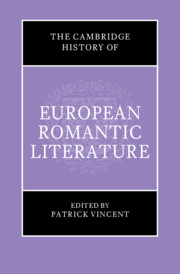Book contents
- The Cambridge History of European Romantic Literature
- The Cambridge History of European Romantic Literature
- Copyright page
- Contents
- Contributors
- Acknowledgements
- Note on the Text
- Chronology
- Introduction
- Part I Romantic Genealogies (1750–1790)
- Part II Revolution to Restoration (1790–1815)
- Part III Restoration to Revolution (1815–1850)
- 14 The ‘Restoration’ of the Restoration
- 15 Late Romanticism and Print Culture
- 16 Global Romanticisms
- 17 No Longer at Ease
- 18 Literatures of the North
- 19 Russian Empire and the Territories of Romanticism
- Further Reading
- Index
15 - Late Romanticism and Print Culture
from Part III - Restoration to Revolution (1815–1850)
Published online by Cambridge University Press: 10 January 2024
- The Cambridge History of European Romantic Literature
- The Cambridge History of European Romantic Literature
- Copyright page
- Contents
- Contributors
- Acknowledgements
- Note on the Text
- Chronology
- Introduction
- Part I Romantic Genealogies (1750–1790)
- Part II Revolution to Restoration (1790–1815)
- Part III Restoration to Revolution (1815–1850)
- 14 The ‘Restoration’ of the Restoration
- 15 Late Romanticism and Print Culture
- 16 Global Romanticisms
- 17 No Longer at Ease
- 18 Literatures of the North
- 19 Russian Empire and the Territories of Romanticism
- Further Reading
- Index
Summary
Focussing on the 1820s and 30s, traditionally seen as transitional decades when many leading Romantic writers passed away, Chapter Fifteen analyses the effects of politics and of the cultural marketplace on literary production, arguing for a late-Romantic episteme recognisable in Britain, Germany, France, Spain, and Italy. After discussing some of problems inherent in the concept of late Romanticism, the author defines it as a series of cultural practices including improvisation, speculation, and performance that reflect the transitory nature of the period. This has been alternately labelled in German literary history as Spätromantik, Biedermeier, and Vormärz, none of which perfectly correspond. Informed by recent research in book and media history, the chapter discusses periodicals’ role in shaping the literary field, in particular Costumbrismo in Spain. These new forms of experimental and ephemeral writing reflect the period’s intense commercialism and consciousness of time, which contrast with the Romantic desire for transcendence. E. T. A. Hoffmann’s last story, ‘Des Vetters Eckfenster’ [My Cousin’s Corner Window], Walladmor, a satirical hoax in imitation of Walter Scott, and Balzac’s Colonel Chabert, serve as examples of late-Romantic tendencies.
- Type
- Chapter
- Information
- The Cambridge History of European Romantic Literature , pp. 458 - 486Publisher: Cambridge University PressPrint publication year: 2023

